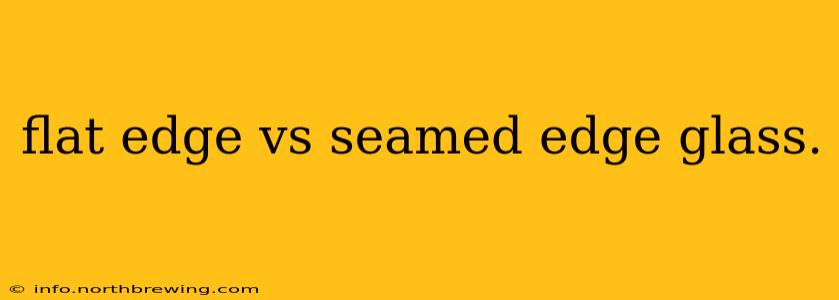Choosing the right type of glass for your project can significantly impact its aesthetic appeal and overall functionality. Two common edge treatments for glass are flat edge and seamed edge. Understanding the differences between these two options is crucial for making an informed decision. This comprehensive guide will explore the characteristics, applications, and considerations for each, helping you choose the perfect edge for your needs.
What is Flat Edge Glass?
Flat edge glass, also known as a polished edge, features a smooth, clean edge that’s precisely ground and polished. This process removes any imperfections or irregularities left from the cutting process, resulting in a sleek, refined finish. The edge is perfectly straight and perpendicular to the glass surface. This creates a modern and minimalist look, ideal for applications where a clean, unadorned aesthetic is desired.
Advantages of Flat Edge Glass:
- Sleek and Modern Appearance: The clean, polished edge lends a sophisticated and contemporary feel to any project.
- Versatility: Suitable for a wide range of applications, including shower enclosures, tabletops, shelves, and more.
- Easy to Clean: The smooth, flat surface is easy to maintain and clean.
Disadvantages of Flat Edge Glass:
- Potentially More Expensive: The precision grinding and polishing process can make flat edge glass slightly more expensive than seamed edge glass.
- More Susceptible to Chipping: While durable, the sharp edge is potentially more vulnerable to chipping than a seamed edge.
What is Seamed Edge Glass?
Seamed edge glass, sometimes called a pencil edge or a beveled edge (though beveled edges have a specific angled cut, not just a simple seam), has a slightly rougher, less refined edge. It's created by simply cutting the glass without any additional grinding or polishing. The edge might appear slightly uneven or textured. This method is generally less expensive than creating a flat edge.
Advantages of Seamed Edge Glass:
- Cost-Effective: The simpler manufacturing process makes seamed edge glass a more budget-friendly option.
- More Durable (in some cases): The slightly irregular edge can be more resistant to chipping than a flat edge, especially in thicker glass.
Disadvantages of Seamed Edge Glass:
- Less Refined Appearance: The rougher edge is less visually appealing than a polished flat edge, making it less suitable for projects where aesthetics are paramount.
- More Difficult to Clean: The textured surface can trap dirt and grime, making cleaning slightly more challenging.
What are the Common Applications for Each?
Flat Edge Glass:
- High-end furniture: Tabletops, shelves, and other decorative elements.
- Modern shower enclosures: Creates a sleek and minimalist look.
- Architectural features: Interior partitions, railings, and other design elements.
- Artwork and displays: Provides a clean frame for showcasing artwork or other exhibits.
Seamed Edge Glass:
- Budget-friendly projects: Where cost is a major factor.
- Applications where aesthetics are less critical: Such as industrial settings or less visible areas.
- Applications requiring extra durability: In some scenarios, the slightly more robust edge can be advantageous.
Which Edge is Right for You?
The best choice depends entirely on your specific project requirements and priorities. Consider the following:
- Budget: Seamed edge glass is generally cheaper.
- Aesthetics: Flat edge glass offers a more refined and modern appearance.
- Durability needs: The relative chipping resistance of each edge type needs consideration, especially for applications that might experience impacts.
- Maintenance: Flat edge glass is easier to clean.
Ultimately, weighing these factors will help you determine whether flat edge or seamed edge glass is the optimal solution for your project. Consulting with a glass specialist can provide further guidance and ensure you make the right choice.
What is the Difference Between a Flat Edge and a Bevelled Edge on Glass?
While both flat and beveled edges are polished, a key difference lies in the shape of the edge. A flat edge is simply a straight, polished edge perpendicular to the glass surface. A beveled edge, on the other hand, features an angled cut and polish, giving it a more decorative and refined look.
Can you cut glass yourself to create a flat edge?
While you can cut glass yourself, achieving a truly flat and polished edge requires specialized tools and expertise. Attempting to do it at home is likely to result in an uneven and potentially dangerous edge. It's best to leave this task to professionals who have the necessary equipment and skills.
Is flat edge glass more expensive than seamed edge glass?
Yes, generally speaking, flat edge glass is more expensive than seamed edge glass due to the additional processing involved in grinding and polishing the edges. The cost difference can vary based on factors like glass thickness and overall project size.
What is the best type of glass edge for a shower enclosure?
For a shower enclosure, flat edge glass is often preferred for its sleek, modern aesthetic and easy-to-clean surface. However, a thicker glass with a seamed edge might provide increased durability if impact resistance is a primary concern.
